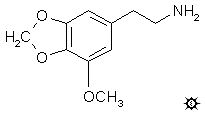
#95 LOPHOPHINE
3-METHOXY-4,5-METHYLENEDIOXYPHENETHYLAMINE
|
| [3D .mol structure] |
A suspension of 25 g LAH in 1.5 L anhydrous Et2O in an inert atmosphere was stirred magnetically, and brought up to a gentle reflux. Through a Soxhlet condenser modified to allow Et2O to return continuously to the reaction mixture, there was added 27.0 g of 3-methoxy-4,5-methylenedioxy-beta-nitrostyrene. The addition require many h, and when it was completed, the reaction was held at reflux for an additional 9 days. After cooling the reaction mixture in an external ice bath, the excess hydride was destroyed by the cautious addition of dilute H2SO4. The final amount used was 1800 mL H2O containing 133 g H2SO4. The phases were separated, and the aqueous phase was washed with 2x100 mL Et2O. To it was then added 625 g potassium sodium tartrate, and sufficient base to bring the pH to >9. This was extracted with 3x250 mL CH2Cl2, and the pooled extracts stripped of solvent under vacuum. The residue was dissolved in anhydrous Et2O and saturated with anhydrous HCl gas, giving a heavy crystallization of salts. These were removed by filtration, Et2O washed, and air dried, to give 17.7 g 3-methoxy-4,5-methylenedioxyphenethylamine (LOPHOPHINE) as an off-white solid with a mp of 160-161 °C. This was dissolved in CH3CN containing 5% EtOH, decolorized with activated charcoal, filtered, and the removed charcoal washed with boiling CH3CN. Slow cooling of the solution provided 11.7 g of a white product which melted at 164-164.5 °C.
DOSAGE: greater than 200 mg.
DURATION: unknown.
QUALITATIVE COMMENTS: (with 150 mg) Between two and five hours, very peaceful and euphoric mood elevation, similar to mescaline, but without any visual distortion. Mild enhancement of color perception, possibly a function of mood elevation. There was no nausea, no eyes-closed vision. Slept easily that evening.
(with 250 mg) Possibly something of a threshold effect from 2:30 to 4:30 of the experiment. Intangible, and certainly there is nothing an hour later.
EXTENSIONS AND COMMENTARY: It looks as if this compound is not active. There is an excellent argument as to why it really should be, and the fact that it is not active is completely unexpected. Let me try to explain.
Quite simply, mescaline is a major component and a centrally active alkaloid of the Peyote plant. It is a phenethylamine, which can undergo a cyclization within the plant to produce a pile of derivatives (tetrahydroisoquinolines) such as anhalonine and O-methylanhalonidine that are marvelously complex alkaloids, all natural components of this magical cactus. But there is another pile of derivatives (tetrahydroisoquinolines) such as anhalonine, and lophophorine, and peyophorine which are the logical cyclization products of another phenethylamine which does not exist in the cactus. It should be there, but it is not. If it were there it would be the natural precursor to a host of bicyclic alkaloids, but it is absent. This is 3-methoxy-4,5-methylenedioxyphenethylamine. I feel that some day it will be discovered as a plant component, and when it is it can be given a name that reflects the generic binomial of the plant. And since the plant has been known as Lophophora williamsii, why not give a name to this compound (which should be in the plant), one derived from the Latin name, but one that has never before been used? What about LOPHOPHINE? And so, I have named it, but I have not found it, nor has anyone else. Yet.
It is inevitable that this simple and most appealing precursor will be found to be present in the cactus, at some future time when we will have tools of sufficient sensitivity to detect it. And certainly, it would be reasonable to expect it to be an active psychedelic, and to be as interesting in man as its close cousin, mescaline. But, at the present time, LOPHOPHINE is not known to be present in the plant, and it is not known to be active in man. I am confident that both statuses will change in the future.
| [ |
[Main Index] | [Forward |

